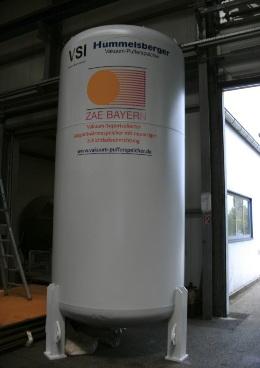Germany: Vacuum Super Insulation Reduces Heat Losses at Long-term Storage
February 4, 2013
 The vacuum super insulation (VSI) by German manufacturer Hummelsberger ensures minimum heat losses when storing solar heat over long periods. This is especially interesting to solar space heating and domestic hot water with a high solar fraction, but also to industrial process heat at higher temperatures. At the SMEThermal 2013 conference in Berlin, Jürgen Melzer, CEO of Hummelsberger, and Manfred Reuß, Group Manager Solar Thermal at the Bavarian Center for Applied Energy Research, ZAE Bayern, explained the design, working principle and possibilities of vacuum-insulated solar storage tanks (see the attached document).
The vacuum super insulation (VSI) by German manufacturer Hummelsberger ensures minimum heat losses when storing solar heat over long periods. This is especially interesting to solar space heating and domestic hot water with a high solar fraction, but also to industrial process heat at higher temperatures. At the SMEThermal 2013 conference in Berlin, Jürgen Melzer, CEO of Hummelsberger, and Manfred Reuß, Group Manager Solar Thermal at the Bavarian Center for Applied Energy Research, ZAE Bayern, explained the design, working principle and possibilities of vacuum-insulated solar storage tanks (see the attached document).
Photo: Hummelsberger Schlosserei GmbH
“Our 15 m³ pilot tank operates with a heat loss rate of 1.98 W / K and loses only 0.23°C per day at a temperature difference of 95 ° C inside and 0 ° C outside,” said Manfred Reuß, whose department at ZAE Bayern is responsible for developing and testing the vacuum storage tank. “This means that in 100 days, the tank’s content cools down by only around 20 K.” In contrast, a large and well-insulated conventional storage tank of the same size loses about 1 K per day or five times as much. With insufficient, e.g., moist heat insulation, the daily heat loss may even be twenty times higher. “The greater the storage capacity, the more significant the differences between a tank insulated with polyurethane foam and a vacuum insulation,” Reuß explained in Berlin.
According to Reuß, VSI is suited for sensitive, latent and thermo-chemical storage. The insulation allows long-term operation without considerable heat losses. For example, this may be appealing to buyers of solar space heating and domestic hot water systems with a high solar fraction. VSI may also be an interesting development for industrial applications at higher storage temperatures, such as process heat in the food industry or district heating.
The excellent thermal insulation is the result of a double-wall steel cylinder whose walls are filled with microporous super-insulating material (perlite) and evacuated between 0.05 and 0.1 mbar. The new tank can hold up to 100 m³ and can be used indoors or outdoors (covered). A special stratification unit keeps the temperature range stable. Currently, the maximum operating temperature is 95 ° C. Storage tanks for higher operating temperatures will be available if necessary.
Manufacturing the tanks poses a huge challenge for the production process, from the precise welding and the inspection for possible leaks to the filling of the annular clearance with perlite. Evacuating a 15 m³ storage also takes approximately three weeks.
This means that the price of a 10 to 15 m³ storage vacuum currently ranges between EUR 20,000 and 25,000, the price for a 30 m ³ tank amounts to 37,000 EUR. “From 35 m³ on, the price for a VSI tank and a conventional tank are identical,” Melzer concluded during the discussion in Berlin.
Four Hummelsberger vacuum tanks are currently in use, with other projects in planning. One of the reference objects is a 20-year old house in Bergen in Southern Germany. Six people live here on 230 m². The house’s energy supply and consumption are being monitored and analysed and be available on the corporate website of Hummelsberger. The assumed energy demand for space heating and hot water is 35,000 kWh per year. The solar system covers nearly two-thirds of it. The system consists of 55 m² of collector area, an 11 m³ vacuum buffer tank and a 2 m³ storage, which is set up inside the building. The remaining demand is met mostly by burning wood. The initial oil burner merely serves as emergency heating.
More information:
http://www.hummelsberger-stahlbau.de
http://www.vakuum-pufferspeicher.de


